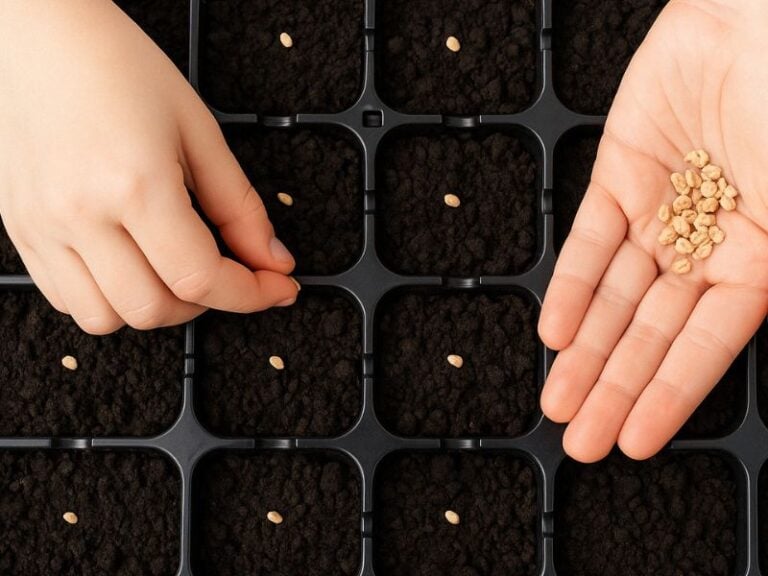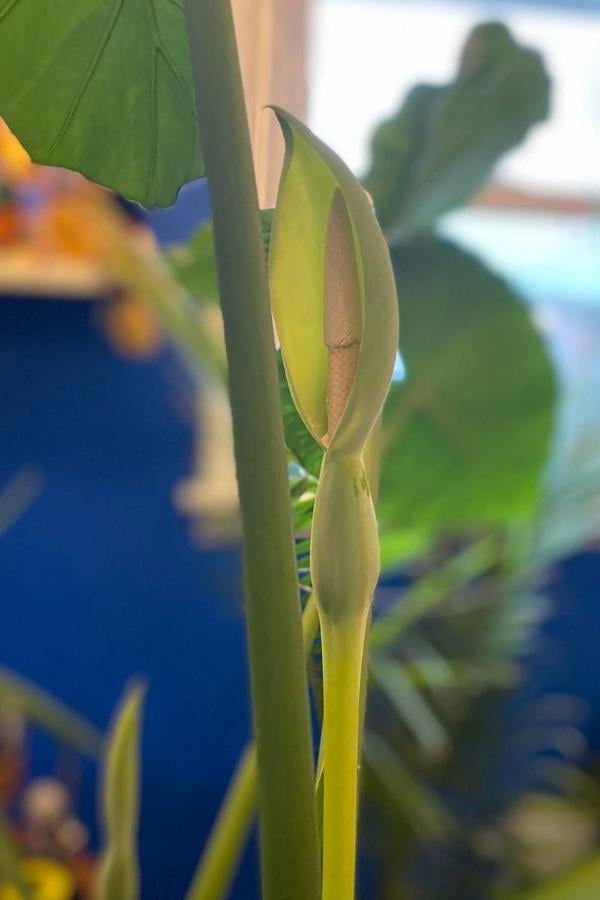The depth of Bird of Paradise roots depends on the variety of plants and the conditions that it is growing in. Plants grown in the ground will usually have a larger root system than those grown in containers and can reach a depth of two feet.
Bird of Paradise plants (Strelitzia nicolai) can make a beautiful addition to your garden, but it’s crucial to pick a suitable variety and understand the plant’s growth habit before planting. Once a Bird of Paradise plant has settled in a position, it’s difficult to move, so it is essential to get it right!
I’ll take you through the different factors that affect Bird of Paradise root growth and the differences between varieties to help you decide which is right for your space.

Contents
Why Does Root Depth and Soil Depth Matter?
Because Bird of Paradise plants needs rich soil to thrive, it’s important to plant them in an area where there is fertile soil at least two feet deep.
The plant’s roots don’t spread out to the sides much, so they need to be pretty deep, otherwise, the plant will struggle to get the nutrients it needs from the soil. The deeper the roots can go, the more of the good stuff they’ll be able to access.
Not only does having deeper roots help the plant to access water and nutrients, but it also helps avoid being uprooted during storms or in strong winds.
It’s important not to plant a plant too deep, however. Planting too deep can cause the plant to struggle as the soil may be too cold at the greater depth and may not contain the nutrients and microorganisms the plant needs to access those nutrients.
Seeds planted too deep are unlikely to germinate because of the lower soil temperature and lack of light penetrating the soil. A rhizome will usually grow best at the same depth as it was taken from the ‘mother’ plant, although it should grow fine if planted at a shallower depth.
Do Bird of Paradise Plants Have Invasive Roots?
You might have heard that Bird of Paradise plants have invasive root systems and should be grown away from concrete, paving, or structures.
However, this isn’t entirely true. You can grow most types of Bird of Paradise plant safely without causing problems for surrounding structures, as long as you pick a suitable variety.
Giant Bird of Paradise plant is the most invasive, with a more extensive and robust root system than smaller varieties. While they probably won’t break up concrete or paving with their root ball, their trunks and basal roots grow very thick.
They could easily damage concrete, paving, or underground pipes if planted too close. These plants also send out suckers which can quickly overwhelm other plants and areas of the garden.
All types of Bird of Paradise plants will regrow from roots left in the soil. If you’re trying to remove one of these plants from your land, it’s vital to remove all the root sections to avoid regrowth.
Bird of Paradise Root System
Bird of Paradise plants has a tuberous root system that grows into a tight ball, reaching up to two feet deep. Specifically, the plant produces rhizomes that grow out horizontally from the root system and produce new plants close to the ‘mother’ plant.
Over time, Bird of Paradise plants can get quite crowded, which affects the life of the original plant and can look unsightly. Therefore, it’s a good idea to dig up and split the new plants off every couple of years or so to prolong the life of the ‘mother’ plant.
Bear in mind, though, that because these plants produce more flowers when their roots are crowded, dividing them may delay flowering or mean that the plants produce fewer flowers until their roots become congested again.
It’s virtually impossible to remove one of these plants by pulling it up – once the plant is settled, you’ll need to dig it out completely to remove it, making sure to catch all the sections of root. The plant will grow back from any remaining rhizomes.
Many people prefer to grow these plants in containers as it makes dividing the plant much more manageable and avoids all of the problems associated with the plant’s aggressive root system.
Bird of Paradise Varieties
The main thing that will affect the root depth of a Bird of Paradise plant is the variety. There are five varieties, S. reginae, and S. juncea being the most suitable for general use.
The giant varieties have deeper, more aggressively growing roots and require a much larger space and more maintenance than the smaller ones, so require careful planning before planting.
- Strelitzia reginae: This is the variety most commonly grown as a houseplant or in gardens (hardiness zones 10-12). It grows up to five or six feet tall and produces beautiful orange and purple blooms throughout the year.
- Strelitzia juncea: This plant is very similar to S. reginae but with narrower leaves and slightly smaller flowers. Often cultivated as a houseplant or for cuttings, it grows three to six feet in height.
- Strelitzia caudata: This plant mainly grows in the wild in southern Africa and is rarely cultivated. It grows up to 20 feet tall and has white tufted flowers.
- Strelitzia nicolai: Commonly known as the Giant Bird of Paradise, this plant can grow up to 30 feet tall. It can be used for landscaping in gardens in hardiness zones 10–12 but can be invasive.
- Strelitzia alba: Sometimes called the white-flowered banana, these plants can grow larger than 30 feet in height. They are not often cultivated and are found growing wild in southern Africa and Madagascar.
Factors That Affect Bird of Paradise Root Depth

Bird of Paradise Root Structure and Size
Bird of Paradise plant roots do not spread wide or very deep but grow in a tightly compacted ball, with horizontal rhizomes producing offshoots that grow into new plants. The roots will grow to fit the surrounding space, eventually reaching around two feet in depth.
The larger varieties have larger roots, but considering how big the plants can grow, they do not develop an extensive root system. However, they can become very heavy and tightly compacted, making them difficult to dig out of the ground.
A tighter root ball encourages more flowers, so it’s a good idea to keep these plants slightly pot-bound if growing them in containers. Plants grown in the ground might not produce as many flowers as those in pots.
Container Depth
Bird of Paradise plants thrives in containers, even the larger S. nicolai. The size of the container will determine the size of the plant.
If you want a large plant, make sure the container is at least two feet deep. For a smaller plant, use a smaller pot, and consider growing the slightly smaller S. juncea.
Of course, if you want to keep the plant small, there isn’t much point in growing S. nicolai in a container. However, if you want to grow this impressive plant without ever having to dig it up, a (very large!) container could be the way to go.
Soil Structure and Quality
Bird of Paradise plants loves rich, slightly acidic soil (pH 5.5-7.5)that is moist and well-draining, with a large amount of organic matter.
They don’t like poor, sandy soils. While they can tolerate clay soil or the occasional drought, you should try to emulate the plant’s natural conditions if you want to produce a large plant with a healthy root system.
Ensure you feed it once a month in the growing season and reduce feeding to give the plant a rest during the winter.
Apply an organic mulch around the base of the plant (keeping it 2-3 inches away from the stem) in spring or fall to provide nutrients and keep the soil moist.
Planting Depth
The correct planting depth is vital for a healthy Bird of Paradise plant. In general, it’s best to plant the root ball of an established plant at a depth equal to the height of the root ball, and a rhizome at the same depth that it was taken from.
Planting Bird of Paradise
| In Container | Outdoor | |
| Planting Depth (plant) | Same height as the root ball 20-30 cm (8–12 inches) | Same height as the root ball 20-30cm (8–12 inches) |
| Planting Depth (rhizome) | 5-10 cm (2-4 inches) | The depth it was taken from |
| Planting Depth (seed) | ½-1 inch | ½-1 inch |
| Eventual Root Depth | Will grow to fill the pot (use a 14-inch pot for a plant of 5-6 feet) | Up to two feet |
| Maximum Plant Height (S. reginae, S. juncea) | Up to six feet in a large pot | Up to six feet |
| Maximum Plant Height (S. nicolai) | Up to 15 feet | Up to 30 feet |
Bird of Paradise plant is generally easy to look after and brings a tropical flair to a space. Although they have a reputation as being invasive, this is only the case with the giant varieties. These plants do spread, though, and need dividing every few years to stay healthy and attractive.
Growing a Bird of Paradise plant in a container helps to avoid the possibility of it spreading outside its allocated spot, makes division much easier, and with larger varieties, completely mitigates the plant’s invasive tendencies.







I just removed a 55+ year old S reginnae. It took 5 days total. What a menace! The roots spread up to 9’ in diameter. I’ve never seen anything like it. Quite fascinating root system. The leaf shoots were so compacted and grew as if piling on top of each other like mussels on a rock in the sea.
The root system was entangled in an equally old F benjaminas root system.
The root ball was at least 2 1/2’ in diameter.
Obvious this Bird was neglected for years. Massive Monstrous Unbelievable
The old girl did not want to go!